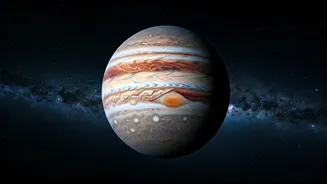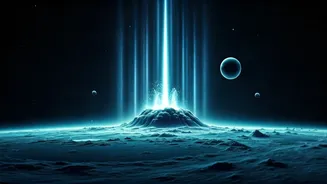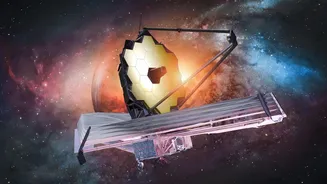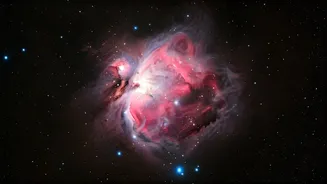Gigantic Size and Scale
Jupiter's sheer size is astonishing, dwarfing all other planets in our solar system. If Jupiter were hollow, over 1,300 Earths could fit inside. Its diameter
at the equator is approximately 140,000 kilometers, more than 11 times that of Earth. This massive size translates to an enormous gravitational pull, influencing the orbits of numerous asteroids and comets within its vicinity. Jupiter's volume is so vast that it accounts for more than twice the mass of all the other planets in the solar system combined. This remarkable scale makes Jupiter a dominant presence, shaping the dynamics of the inner solar system and providing a crucial gravitational shield against potential space hazards. The planet's powerful magnetic field, the strongest in the solar system, further emphasizes its colossal magnitude, extending far beyond the planet itself and interacting with solar wind in remarkable ways. This large size contributes significantly to its influence on the solar system as a whole.
Atmospheric Composition
Jupiter's atmosphere is primarily composed of hydrogen and helium, mirroring the composition of the Sun. Trace amounts of other gases, such as methane, ammonia, and water vapor, contribute to the planet's vibrant colors and weather patterns. These elements absorb and reflect sunlight in unique ways, creating the distinct bands and zones that characterize Jupiter's appearance. The fast rotation of Jupiter causes its atmosphere to swirl rapidly, generating powerful jet streams and complex cloud formations. These atmospheric dynamics are responsible for the planet's iconic features, including the Great Red Spot, a colossal storm that has raged for centuries. The atmospheric pressure increases significantly with depth, with the hydrogen eventually transitioning into a metallic state at extreme pressures. This metallic hydrogen is believed to be the source of Jupiter's powerful magnetic field. The ongoing study of its atmosphere continues to reveal insights into the planet's weather systems, cloud structures, and the behavior of the gases that comprise it.
The Great Red Spot
The Great Red Spot is perhaps Jupiter's most recognizable feature, a giant, persistent anticyclonic storm that has been observed for centuries. Its size varies over time, but it is typically large enough to swallow Earth entirely. The spot's reddish hue is believed to be caused by the presence of complex organic molecules, such as those containing phosphorus or sulfur, that are lifted from the planet's deeper atmosphere. The Great Red Spot is a complex vortex with winds that can reach speeds of up to 432 kilometers per hour. Its rotation period is about six Earth days. While scientists continue to study the storm's dynamics, the longevity of the Great Red Spot is a subject of ongoing research and speculation. The storm has been shrinking over time, and its future behavior is uncertain. The continuous observation of the Great Red Spot offers scientists a unique opportunity to study the long-term behavior of storms within a planet's atmosphere and the complex interactions between atmospheric layers.
Jupiter's Ring System
Jupiter, like Saturn, possesses a ring system, although Jupiter's rings are far less prominent and complex. The rings are composed of dust particles, primarily ejected from Jupiter's inner moons. The main ring, a broad, relatively faint structure, is believed to originate from the moons Metis and Adrastea. The halo ring is an inner, diffuse ring extending toward the planet. The gossamer rings are faint, outer rings associated with the moons Amalthea and Thebe. The particles that make up Jupiter's rings are constantly replenished by impacts from micrometeoroids and ejecta from the moons. Unlike Saturn's rings, which are composed of ice particles, Jupiter's rings are primarily made up of dust, a characteristic that makes them much fainter and less visually striking. The ring system's composition is closely linked to the planet's moons, serving as a dynamic record of the ongoing interactions between Jupiter's satellites and their environment. The study of the rings helps scientists understand the mechanics of particle distribution within the Jovian system, and the processes that shape planetary rings overall.
Jupiter's Moons: Galilean Satellites
Jupiter has a vast and diverse system of moons, with the four largest, the Galilean moons (Io, Europa, Ganymede, and Callisto), being among the most fascinating. Io is the most volcanically active world in the solar system, with hundreds of active volcanoes spewing sulfur-rich plumes. Europa is covered in a smooth, icy shell, which hides a global ocean beneath its surface, making it a prime candidate for the search for extraterrestrial life. Ganymede, the largest moon in the solar system, has its own magnetic field, a unique feature among moons. Callisto is heavily cratered, with an ancient surface that provides insights into the early solar system. These four moons were discovered by Galileo Galilei in 1610, revolutionizing our understanding of planetary systems. Each moon offers a unique environment for scientific investigation, contributing significantly to our comprehension of planetary formation, geological activity, and the potential for life beyond Earth. The ongoing exploration of Jupiter's moons provides new and exciting discoveries that reshape our understanding of the universe.
Spacecraft Exploration of Jupiter
Several spacecraft have visited Jupiter, providing invaluable data and stunning imagery of the planet and its moons. Pioneer 10 and 11 were the first to fly by Jupiter in the 1970s, providing initial close-up views. The Voyager 1 and 2 missions, also in the 1970s, offered more detailed observations of the planet's atmosphere, magnetosphere, and moons. The Ulysses mission studied Jupiter's magnetosphere and its interaction with the solar wind. The Galileo spacecraft, which orbited Jupiter from 1995 to 2003, delivered the most comprehensive data yet, including atmospheric probes and detailed studies of the Galilean moons. The Juno mission, currently orbiting Jupiter since 2016, is focused on studying Jupiter's interior, gravitational and magnetic fields, and atmospheric composition, aiming to enhance our understanding of the planet's formation and evolution. These missions have transformed our understanding of Jupiter, and future missions promise even more exciting discoveries. Spacecraft have helped map Jupiter's complex magnetic field, studied its internal structure, and revealed the intricate atmospheric dynamics. The data obtained from these missions have helped scientists to understand the formation and evolution of the solar system.












